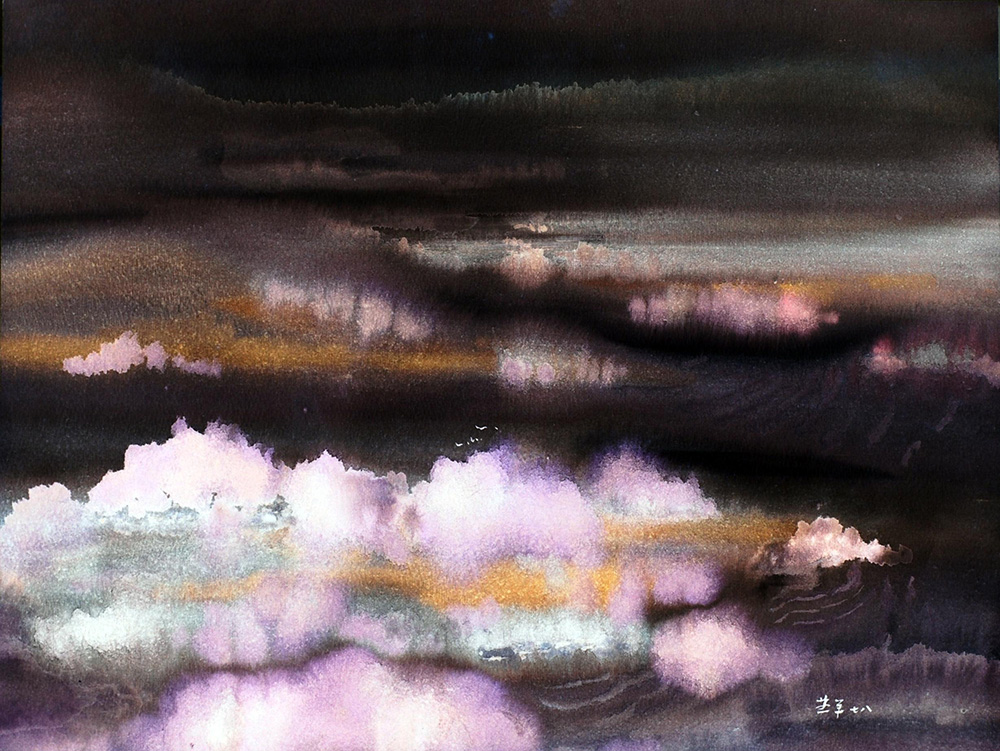
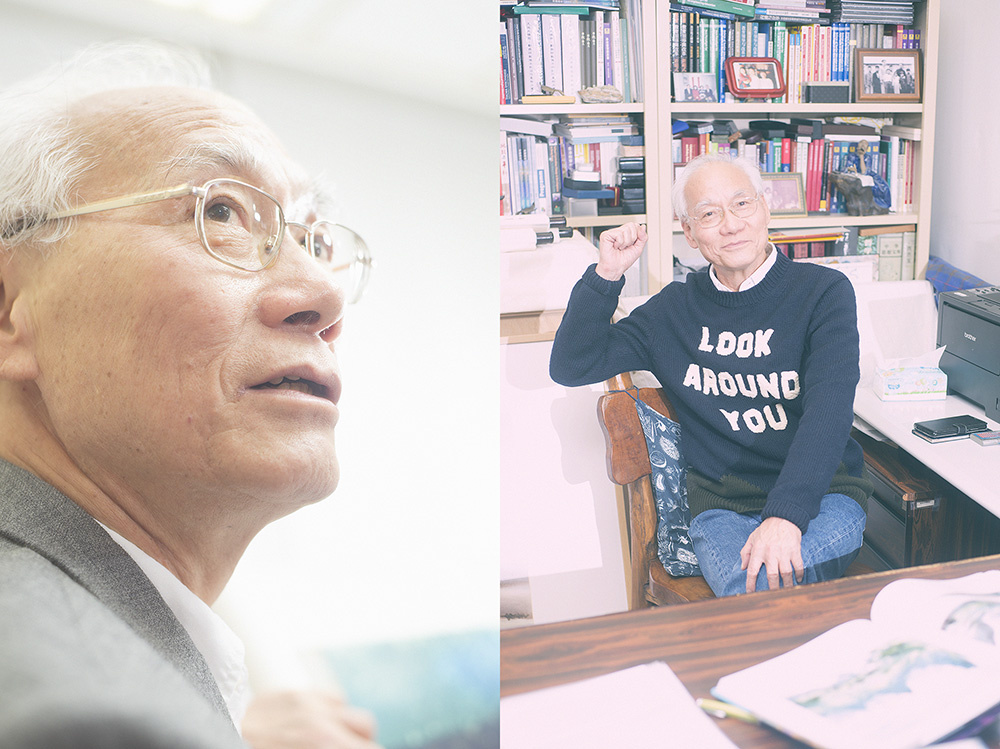
Left/左 : Professor Cheng Yin Cheong wears blazer by COS, white shirt his own. 鄭教授穿上COS 西裝,自已的白恤衫。 // Right/右 : He wears sweater and jeans by Sandro Homme, white shirt his own. 衛衣和牛仔褲 Sandro Homme,自已的白恤衫。
Artwork : 時空挪移【2】- 山居 【1978/2014】// Space-Time Transforming 【2】- Living in Mountain 2【1978/2014】
攝影及訪問 / Photos and Interview : Nick D for @precursorprints
中文撰文 / Chinese Translation : Lorien Chan
造型 / Stylee : 2 Dirty Guys for @precursorprints
攝影助手 / Photo Assist : Ric So
A day wandering aimlessly through Jordan, Kowloon saw me venture into the Commercial Press bookstore there and it’s Chinese art section. Thumbing through a few tomes, the artwork of professor Cheng Yin Cheong blew me away, and utterly changed the pace of my day. It’s contents, encompassing a lifetime of his watercolour paintings were stylish, vibrant, and thoroughly modern. Curious as to who’s work this was, it was a pleasant surprise to discover that Prof. Cheng Yin Cheong was from Hong Kong! His academic credentials were unparalleled. Having a doctorate from Harvard University even! I set out to get his story, as to why such a talent would be so low profile here in Hong Kong, and I am more than happy to share this interview with you.
你相信緣份嗎?有天我漫無目的地在佐敦亂逛,不知為什麼的就走進了一家書店,又不知怎樣的走到了中國藝術的書架前面。這種精神狀態,我根本就沒有心機看書架上任何一本書籍,不過是打發一下時間。突然之間一本畫冊吸引著我的目光,冊上色彩斑斓的水彩畫充滿活力、富現代感和又時尚,整個人頓時豁然開朗。我對這個畫家的工作十分好奇,仔細地看看到底是出自那位名家大師,才發現是來自香港的一個學者,鄭燕祥教授的作品。他的學歷背景十分厲害,哈佛畢業的鄭教授是個教育工作者、也是個推動中國文化藝術的先驅。為什麼這樣了不起的人材如此低調?於是我鼓起勇氣致電他相約了一次訪談的機會,這奇怪的經歷除了用緣份去形容,我也想不到別的形容了。
< <中文譯本在英文之後 >>
SPITGAN : Hello Prof. Cheng, thank you for letting us interview you. Can you introduce to us your background in art?
PROF. CHENG YIN CHEONG : I enjoy art and its creation very much. Unfortunately I do not have any formal training and qualification in art even though I hold a doctoral degree from Harvard University.
My interest in art started at the end of the 1960s when I was a physics student at The Chinese University of Hong Kong. After graduation in 1971, I began my career as a physics teacher as well as my long journey as an amateur painter. From 1985 to 2014, I was invited to hold six personal art exhibitions with the support of various cultural and art organizations. I was also invited by the Hong Kong Museum of Art to conduct special public lectures on the artwork of famous Hong Kong artists including Mr Gaylord Chan, Mr Hon Chi-fun, and Mr Ha Bik-chuen.
SG : You chose painting as your medium of expression over others, and watercolors in particular. Why?
CYC : In the beginning, I was very impressed by large sculptures. I planned to pursue sculpture but was unable to master the sophisticated techniques. In comparison, painting with watercolors was much easier, particularly for the beginners.
To me, medium is important, but more important is the creative ideas I express.
Finally, I chose and fell in love with watercolors, with which I could integrate the strengths of Western watercolor painting and Chinese ink painting to create my own painting style. The flow of watercolors on wet paper can create a lot of unexpected visual effects, it all depends on your imagination.
Watercolor painting becomes an exploration in which you may not know the outcome until completion of the painting. I believe I was very lucky to have chosen watercolors as my major art tool.
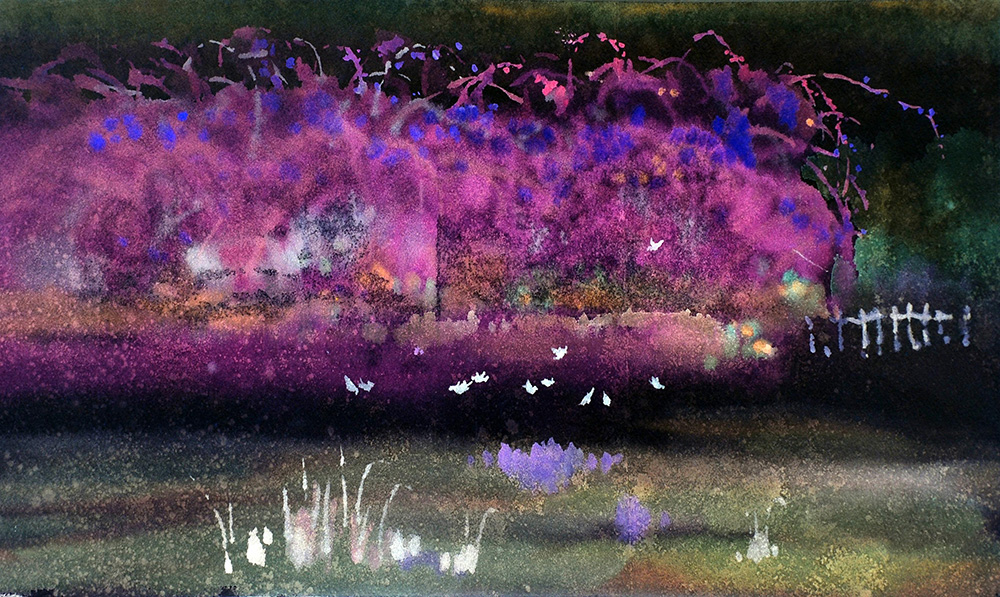
Artwork : 時空挪移【13】- 圍牆外【1975/2016】// Space-Time Transforming【13】- Beyond the Wall【1975/2016】
SG : What draws you to landscapes? It is clearly your favorite subject to paint.
CYC : A very good question. To some extent, its answer relates to my cultural root or philosophical view. In Asian or Chinese traditions, great artists often respect nature, the universe, and “Dao” (道) very much. In particular, they try to integrate their personal feelings, perceptions and emotions implicitly with the natural landscapes they paint. Accordingly, the expression of landscapes may represent the artists’ styles and views about themselves.
To me, I would like to say that the mountains, trees, and landscapes I painted are my mountains, my trees and my landscapes because they represent the personal ways or views of my life.
Another technical answer to your question. There are unlimited possibilities and approaches that can be adopted to express different aspects of landscapes. It means that it will be much easier and freer for me to paint landscapes than other subjects because their possible images (in terms of shape, content and color) are unlimited.
CONTINUE READING THE INTERVIEW AND SEE MORE OF PROF. CHENG YIN CHEONG’S WORK :
SG : Have you participated in the big art fairs in the city like Art Basel or Art Central?
CYC : No. I have not thought about it yet. Maybe, I should let more people know about my artwork.
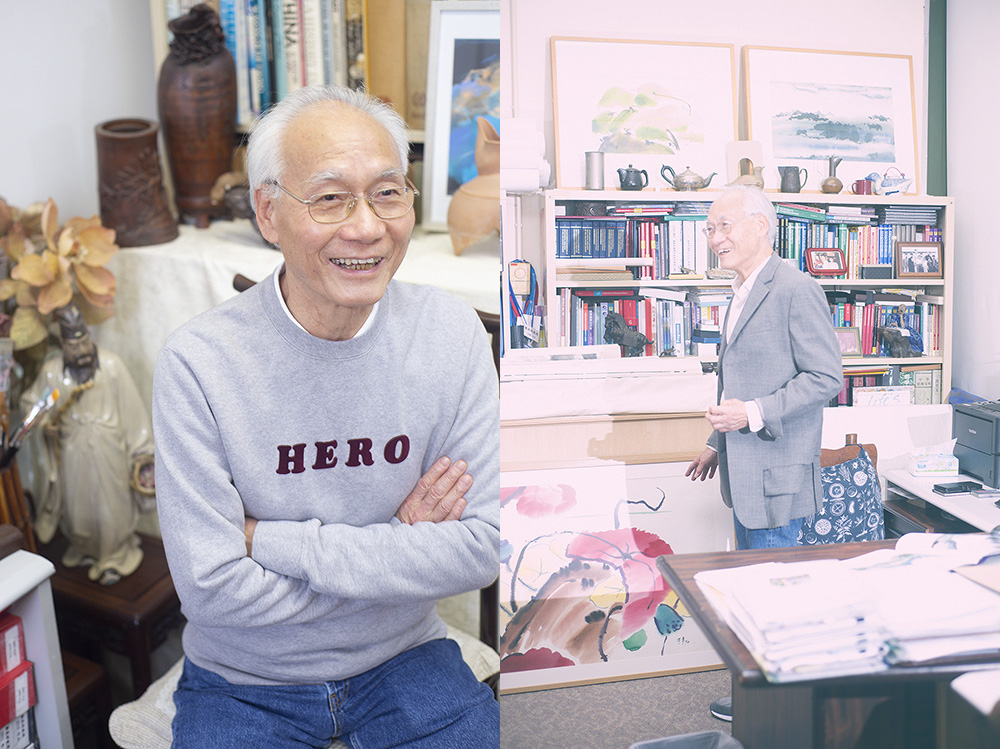
Left/左 : Professor Cheng Yin Cheong wears sweatshirt and jeans by Sandro Homme, white shirt his own. 衛衣和牛仔褲Sandro Homme,自已的白恤衫。// Right/ 右 : He wears blazer by COS, jeans and sneakers by Sandro Homme, white shirt his own. 灰色西裝COS,牛仔褲和運動鞋Sandro Homme,自已的白恤衫。
If you like this article check out our interview with Japanese artist Takeo Hanazawa :
http://blog.spitgan.com/%E8%8A%B1%E6%B3%BD%E6%AD%A6%E5%A4%ABtakeo-hanazawa-funk-phenomenon/
SG : In our research we found the majority of the information about you was from your academic accomplishments and very little about your artwork. Why is that?
CYC : As my major job responsibilities, I was chair professor and vice president of the Education University of Hong Kong and also the president of the World Education Research Association and the Asia-Pacific Education Research Association. I published a lot academically in the past years. This may be the reason why the majority of the information you found about me was about my academic accomplishments. Comparatively, my artwork was not so well known.
In Hong Kong, it is too expensive to hold a personal art exhibition or publish an art book to promote your artwork. It is not surprising that the public may not know the artists. Fortunately with the support of the Hong Kong Arts Development Council, I have recently published a book of my artwork entitled “Transforming mind: The Art of Cheng Yin Cheong (若意挪移: 鄭燕祥創作畫集)”. It is a compilation of 146 pieces of my artwork. Probably with this book, more people will know the other side of my work.
SG : “(As) I did not feel the pursuit of science could be directly related to the struggles of people, I developed a keen interest in art.” A phrase of yours that caught my eye. Do you still feel this way?
CYC : This was my feeling when I was an undergraduate long time ago. It may not be so important now whether I still have the same feeling or not. But I believe I was very lucky to have made up my mind to pursue art beyond physics at that moment. The journey in the last 40 years with art has changed my life.
SG : You only began exhibiting your work in the early 2000’s? Is that accurate? What was the reason behind this, you have been painting since the 70’s.
CYC : Yes, it is accurate. I held a small personal exhibition at the Faculty of Education of the Chinese University of Hong Kong in 1985. The formal exhibitions of my work only began in the early 2000’s with the support of several cultural and art organizations.
There may be two reasons. Firstly, as mentioned above, it was really too expensive to hold a personal art exhibition even for a few days. As a teacher, it was nearly impossible to hold any exhibitions without substantial support from galleries or sponsors. Secondly, from mid 1980s to 1990s, I had been totally committed to my academic work and research in education. During this period, I stopped nearly all my artwork. All my energy, creativity and imagination had gone to my academic endeavors at the international frontier.

Artwork : 樹之隨生【3】- 黑樹【1974】// Tree at Creation【3】- Black Tree【1974】
SG : You have mentioned to us that you are applying new technologies to your painting techniques can you elaborate and share more with us about what you are doing?
CYC : Watercolour painting is a fantastic mode of expression as I mentioned, but it also has many limitations. For example, it is difficult to create a painting of very large scale, test the visual effects of color changes, and manage the timing of watercolor drying.
In the beginning of the 2000s, I found that the integration of watercolour painting with digital processing can enhance the scope of creation possibilities and create a new vision domain within the world of watercolours. It allows me to break through from the limitations of traditional watercolour techniques, change colour palettes, brightness and appearance, and thus create entirely new visual atmospheres and effects while conveying a strong humanistic sense expressed through the artist’s personal style.
I describe this creative approach as “qiankun nuoyi” ( 乾坤挪移,literal meaning: universe transforming). It highlights the relative nature of yin (陰) and yang (陽), strong and weak, black and white, tall and short, all of which can be interchanged and manipulated to create completely new visual impact and to create effects of time and space transformed.
Over the past few years, I have also experimented with transforming the day and night views of Hong Kong, creating highly contrasting visual effects using the “qiankun nuoyi technique”. The effects of these transformations show my sentiment towards Hong Kong’s harbour and urban areas.
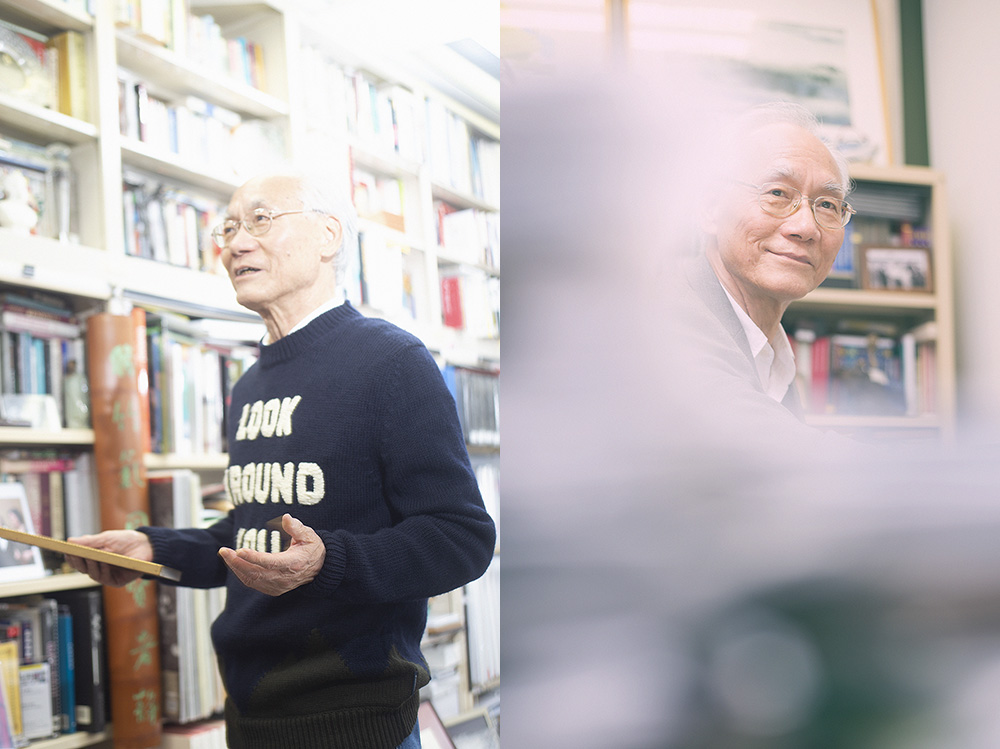
Left/左 : Professor Cheng Yin Cheong wears sweater and jeans by Sandro Homme, white shirt his own. 衛衣和牛仔褲 Sandro Homme,自已的白恤衫。// Right/右 : He wears blazer by COS, white shirt his own. 鄭教授穿上COS 西裝,自已的白恤衫。
For those interested in Professor Cheung Yin Cheong’s art work, his book can be purchased from :
Large book stores such as中華書局(Chung Hwa Book Co), and 商務印書館(The Commercial Press)
Online : https://www.cp1897.com.hk/
You may also visit the display of some of his large paintings at the “Library of The Education University of Hong Kong”, Lo Ping Road, Tai Po, NT.
SG : Will new technologies attract more young people to Chinese Ink Painting? What do you think interests them?
CYC : Yes, it may attract more young people. But I have to say, new technology is only a new tool or a new opportunity for them to try in their artwork. It cannot replace the key role of their artistic imagination and creative ideas in art making in general, and Chinese ink painting in particular.
I believe it is possible to enhance young people’s creativity and imagination through the use of the “qiankun nuoyi technique”.
SG : You took quite a hiatus from painting in the 90’s any reason why? Yet you paint to this day? Do you think you can ever truly stop?
CYC : As I answered to question 7, I committed myself completely to my academic work in education research in the 1990s. During this period, I had not produced any substantial artwork. It is really a big hiatus in my art life.
What is fortunate is that my finest artwork from the 1970s and 1980s has been quite well-protected and preserved. Representing the very deep and fine accumulation of my life in art, all these paintings have become a very warm calling to me to continue my journey in art whenever possible.
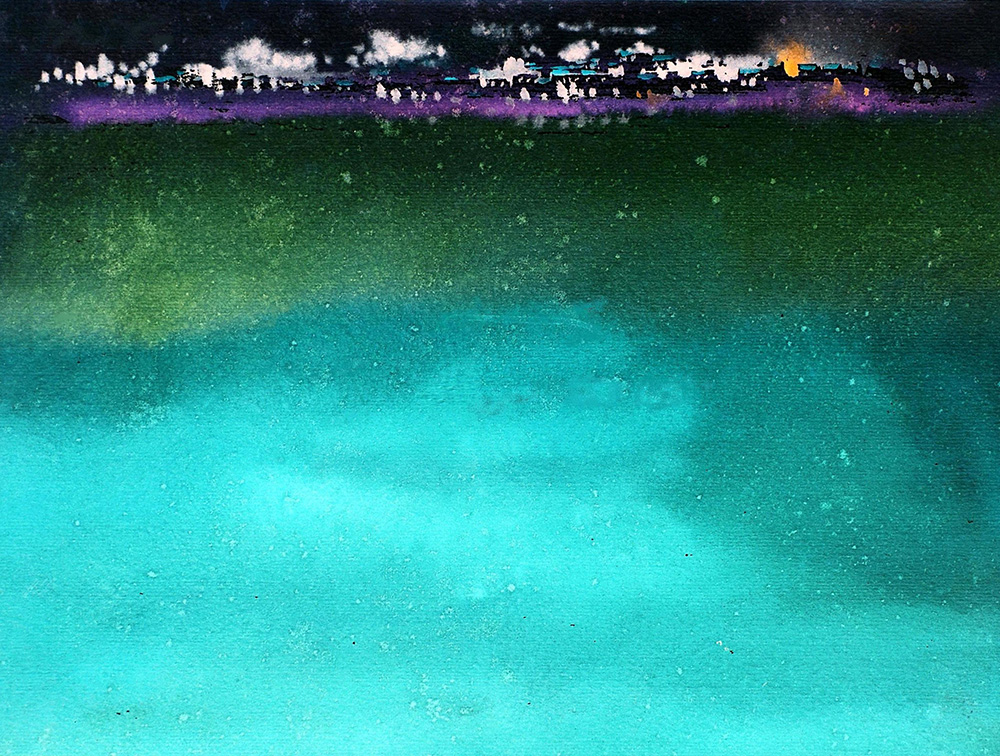
Artwork : 天地挪移【15】- 海天【1975/2016】 // World Transforming【15】- Sea and Sky 【1975/2016】
SG : What is art?
CYC : To different people or artist, the meaning of art may be completely different. It may be very controversial in a public discussion. Personally, I would like to take art as an exploration both externally about the world around us and internally into the world within ourselves, and there is an interactive process between the two before an artwork is created. The following extract from my book “Transforming Mind” may give some insight:
“I create therefore I am” (我創故我在). To me, artistic creativity is an extension of life, ever emitting light and heat.
….I often ask myself – can I transfer the rhythmic vitality and the spirit of abstract art to representational paintings? Can the spirit of figurative art be taken to the next level and become an element of abstract paintings? How are these related to my inner world and my view on art? There are no obvious answer to these questions.
In the 1970s, I began to look for deeper meaning from depicting natural phenomena and urban observations. I sought to understand the underlying intention behind the paintings as well as their spirit and rhythm. I hope that my paintings will be guided by intentions (若意), changing both the appearance and spirit while transforming its rhythm. In doing so, I strived to realise new artistic ambitions.”
SG : Do you think Hong Kong has a good education system for art?
CYC : I have not done any research on this issue. I may not have too many useful comments and suggestions. From other data, we can see that many students are overloaded with formal curriculum and examination and they may not have much time to learn and practice art. The role of art education and art activities is often neglected in schools.
As Hong Kong is a very active and open international city, I think there should be a lot of good opportunities and international resources for art development and creativity building in school education. How to establish the necessary infrastructures and policies for art education in the Hong Kong education system is an important issue for policy makers and those concerned.
SG : It seems modern art is full of story. Very conceptual but not very beautiful. Between concept and beauty, which one is most important?
CYC : This is an interesting issue. As we know, modern art has largely broadened the meaning and scope of art. To some extent, the meaning of art has been unlimitedly extended to include nearly everything. It may become a kind of philosophical argument that art should be presented conceptually instead of appreciated traditionally. If so, it is not surprising that many people get confused with the meaning and purpose of art and lose their direction in art endeavor. To them, the original pursuit of beauty in art may be gradually disappearing.
Personally, I prefer to have both concept and beauty in my painting. If we have only “beauty” without any new perspectives or creative concepts, I do not think this kind of beauty will have long lasting values as a humanistic endeavor. If we emphasize only “concept” without any element of beauty, then it would be hard for us to understand why it is still an art.
SG : You seem very surprised that we wanted to speak to you. Why?
CYC : From my perception, I am not in the world of yours, the fashion sector. Even though I understand fashion design benefited a lot from modern art and design, my artwork may be still too remote from your sector. In particular, some of my artwork are already 40 years ago.
Therefore, I am very interested to know why you wish to talk to me. Probably, you have already thought through the boundary between the art of fashion and my art. Let us chat on this.
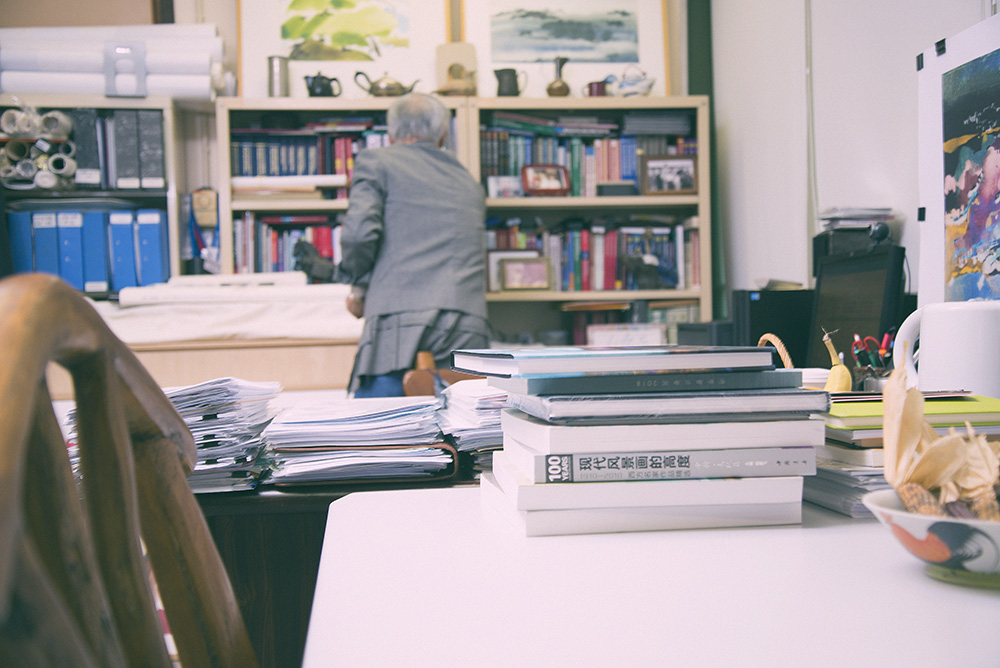
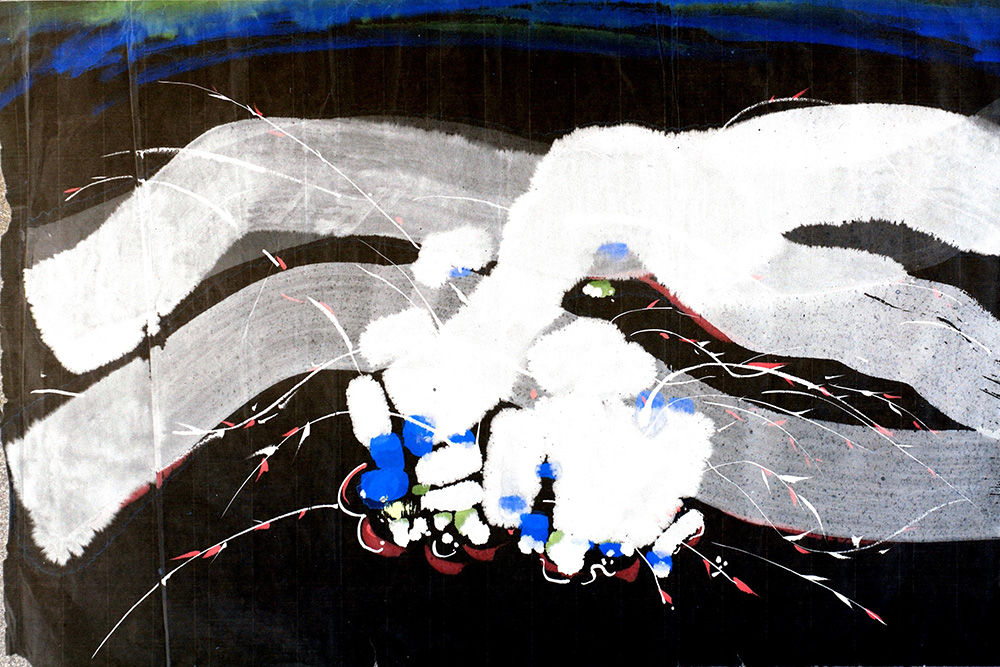
Top : Professor Cheng Yin Cheong wears blazer by COS, jeans by Sandro Homme, white shirt his own. 灰色西裝COS,牛仔褲和運動鞋Sandro Homme,自已的白恤衫。
Artwork : 天地挪移【12】- 山變3【2006/2014】 // World Transforming【12】- Mountain Change 3【2006/2014】
SG : How can one start to understand/appreciate Chinese ink painting? Your work?
CYC : There are different approaches to Chinese ink painting. To different people, the styles and visual effects of Chinese ink painting they like may be different. What kind of Chinese ink painting one likes may be the starting question for understanding and appreciation.
In my view, there should not be a big difference between watercolor painting and Chinese ink painting. Both of them are only a tool. The key is how we can use them well to express what we wish to pursue and paint with our own style. Of course, I welcome those interested to have a look at my artwork as a start.
SG : What are the unique challenges of an artist in Hong Kong?
CYC : In the past 40 years, I have come to know many artists in Hong Kong. Most of them are committed amateur artists, struggling for a balance between their career to make a living and their interest in art. Very few can earn a living from “full time” art.
I think the unique challenges of an artist in Hong Kong include the high cost of exhibiting and promoting their artwork, lack of working space for art making, shortage of a critical mass of renowned artists to lead them, and absence of a strong culture and market to support art activities.
Check out our interview with Hong Kong musician Jun Kung here :
http://blog.spitgan.com/jun-kung-hong-kong-recording-artist/
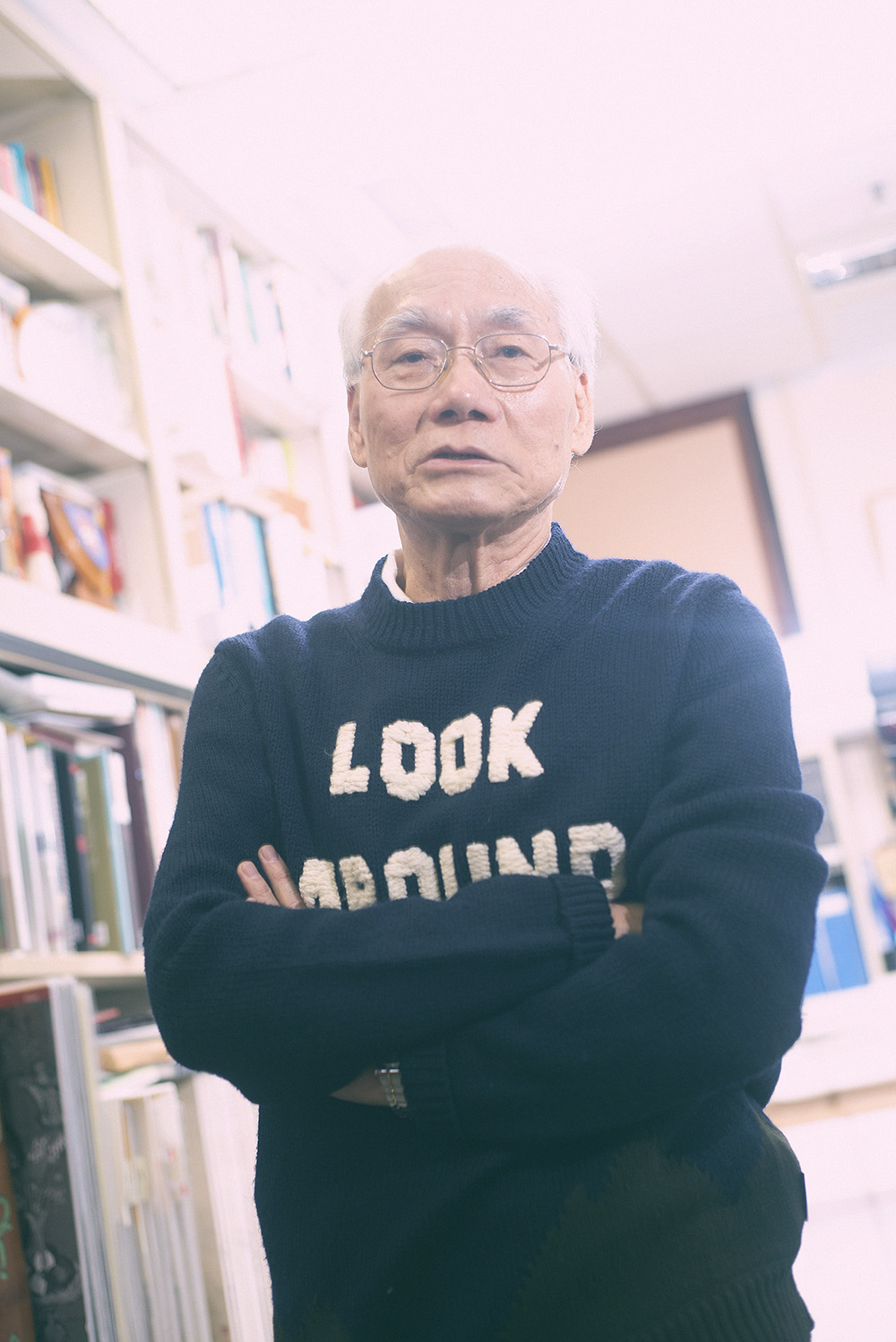
Professor Cheng Yin Cheong wears sweater by Sandro Homme, white shirt his own. 衛衣和牛仔褲 Sandro Homme,自已的白恤衫。
SG : Some people think painting is dying, and being replaced by photography. What do you feel about this notion?
CYC : Painting and photography are two different things, representing different types of art activities. It is difficult to make any comparison.
In the business world, photography equipped with cameras of high technology seems to be a much more efficient and powerful way to earn a living and reputation than painting. It is not a surprise that more and more people like to use photography than painting.
In terms of free artistic imagination and emotional expression, I believe painting is still better than photography.
SG : How can we rekindle interest in Chinese Ink Painting so it will not disappear? Or is this a natural process?
CYC : As I explained in questions 9 and 10, the integration of Chinese ink painting/ watercolor painting with new technology can break free from their traditional limitations, enhance the scope of creation possibilities and discover new vision domain within the traditional world. I believe this creative approach “qiankun nuoyi ( 乾坤挪移) ” may help to rekindle interest.
SG : Your current works. Can you describe this period for us?
CYC : After the recent publication of my new art book “Transforming Mind: The Art of Cheng Yin Cheong” (2018)”, I have got a comprehensive understanding of my art world in the past 40 years and the new application of the creative approach “qiankun nuoyi”.
Currently, I am further experimenting with applications of “qiankun nuoyi ( 乾坤挪移) ” into the different types of my artwork, to test my “Theory of Relativity” for visual art making. I am hoping that this theory can help art lovers or artists to appreciate the meaning and dynamics behind art making and to discover their own ways to express their own world.
I am now looking for a business sponsor who can support the experiment by producing and exhibiting a large scale artwork in Hong Kong with this approach. Let us image how the Hong Kong people would respond to this art initiative.
Would you be interested to be a sponsor?
SG : Please share with us some Hong Kong artists you appreciate and/or inspire you.
CYC : I like very much the artwork of Mr Gaylord Chan (陳餘生), Mr Hon Chi-fun (韓志勳), and Mr Ha Bik-chuen (夏碧泉). I had done some comprehensive research on their artwork when preparing the three public lectures at the Hong Kong Museum of Art. I was very impressed with their unique creativity and lifelong art accomplishments. Very inspiring indeed. As Hong Kong people, we are proud of them.
< <中文譯本在下面 >>
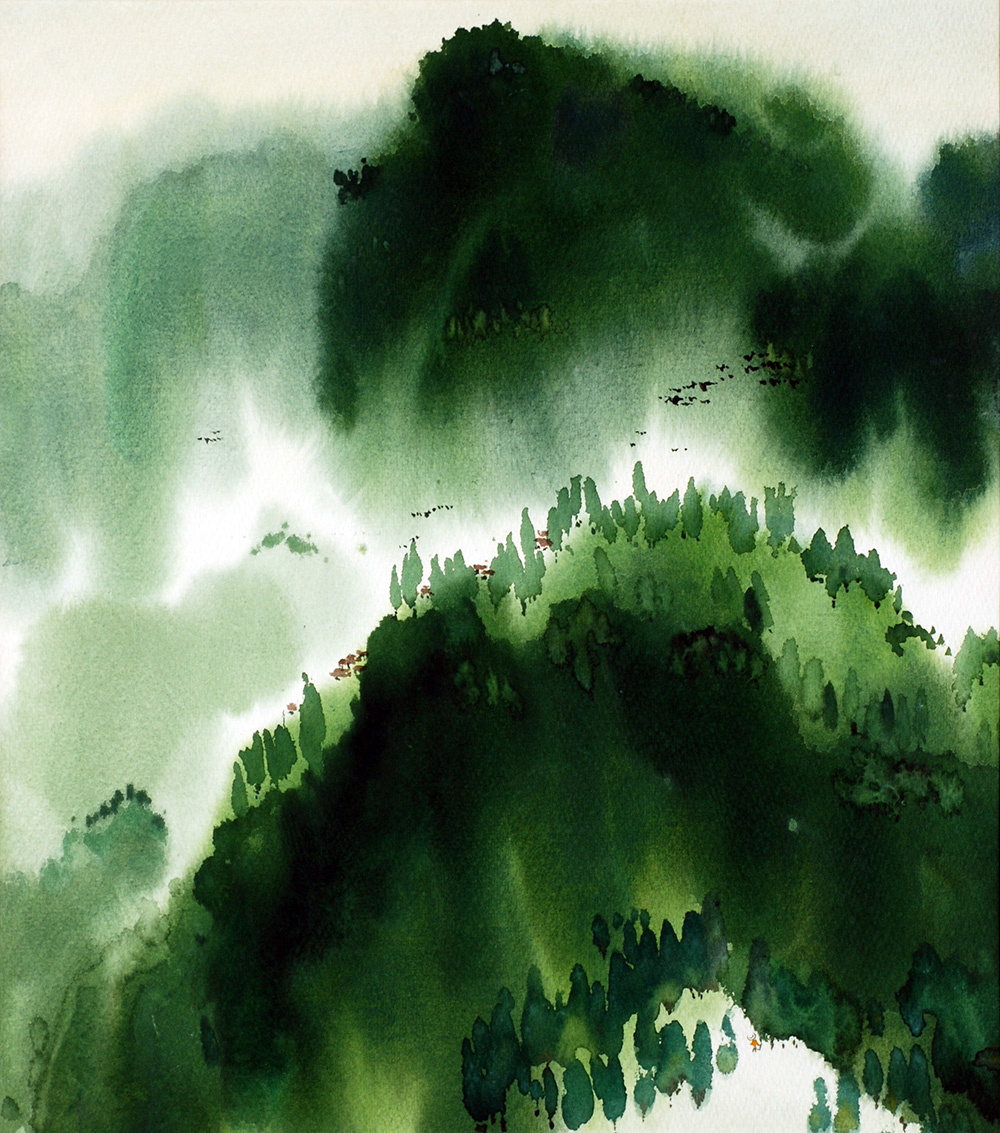

Left/左 : Professor Cheng Yin Cheong wears blazer by COS, jeans and sneakers by Sandro Homme, white shirt his own. 灰色西裝COS,牛仔褲和運動鞋Sandro Homme,自已的白恤衫。
Artwork : 山之隨想【5】- 尋山【1981】 // Mountain at Imagination 1【1981】
SPITGAN : 你好鄭教授,感謝你接受訪問。你可以介紹一下你在藝術方面的背景嗎?
鄭燕祥教授 : 我享受藝術和創作。不過雖然我擁有哈佛的博士學位,但卻沒有任何正式在藝術的培訓和資格。我對藝術的興趣始60年代末,當時我是香港中文大學的物理系學生。1971年畢業後,我開展了當物理老師的職業生涯,同時也開始了當一個業餘畫家的漫長旅程。從1985年到2014年,我受邀在各種不同文化藝術組織的支持下舉辦了六次個人藝術展覽。香港藝術館亦曾邀請過我參與有關香港一些著名藝術家的藝術作品的特別公開講座,當時的嘉賓包括陳嘉庚先生,韓志勳先生及夏碧泉先生。
SP : 你選擇了畫畫,特別是水彩畫作為你主要的創作表達媒介,為什麼?
鄭燕祥 : 一開始其實我對大型雕塑的印象是最為深刻的,我計劃過追求在雕塑方面的發展但卻無法掌握複雜的技巧。相比之下,水彩畫容易得多,而且特別適合初學者。對我而言,藝術媒介當然重要,但更重要的是我表達的創意。最後我選擇並愛上了創作水彩畫。我可以將西方水彩畫和中國水墨畫的優勢融合在一起,創造出我獨有的繪畫風格。水彩在濕紙上的流動會產生許多意想不到的視覺效果,不過這一切取決於你的想像力。就像一種探索旅程,在繪作完成之前你不會知道結果。我相信能選擇水彩作為我的主要藝術工具是一個幸運。
SP : 顯然你最喜愛的主題是風景畫,這有什麼吸引你的地方?
鄭燕祥 : 一個很好的問題。在某種程度上,這個答案與我的文化根源或哲學觀點有關。在亞洲或中國傳統中,偉大的藝術家都很尊重自然,就是宇宙和「道」。他們會試圖將個人感受、感知和情感,與他們描畫的自然景觀完美地結合起來。因此,不同景觀的表達可以代表藝術家的風格和對自己的看法。
對我而言,我所繪畫的山、樹、風景都是我的山、我的樹、我的風景。一切都是代表了我的個人生活方式或者觀點。另一層技術一點的答案,是因為在圖像上表達景觀的形狀、內容和顏色都是沒有限制的,可以有無限的可能性和方法來表達景觀的不同方面。這代表繪畫風景畫比其他主題更容易和更自由。
SP : 你有參加過大型的藝術展,例如Art Basel或Art Central嗎?
鄭燕祥 : 沒有,我沒想過。或者我應該要讓更多人知道我的作品。
SP : 在我們尋找你的時候,發現大部份關於你的信息均來自你的學術成就上,很少關於你的藝術作品。這是為什麼?
鄭燕祥 : 最主要是因為我的工作職責,我曾擔任香港教育大學的主席教授和副校長、世界教育研究學會的會長以及亞太教育研究學會會長。因此過去幾年間我在學術上發表了許多文章。這大概是你找到大部份我的信息都是有關教育成就的原因吧。相比之下,我的藝術作品並不是那麼出名。
而且在香港舉辦個人藝術展或出版藝術書來宣傳您的作品太貴了,公眾對藝術家不了解也不足為奇。幸運的是,在香港藝術發展局的支持下,我最近出版了「若意挪移: 鄭燕祥創作畫集」。這是我146件作品的彙編。也許有了這本書,更多的人會知道我工作的另一面。
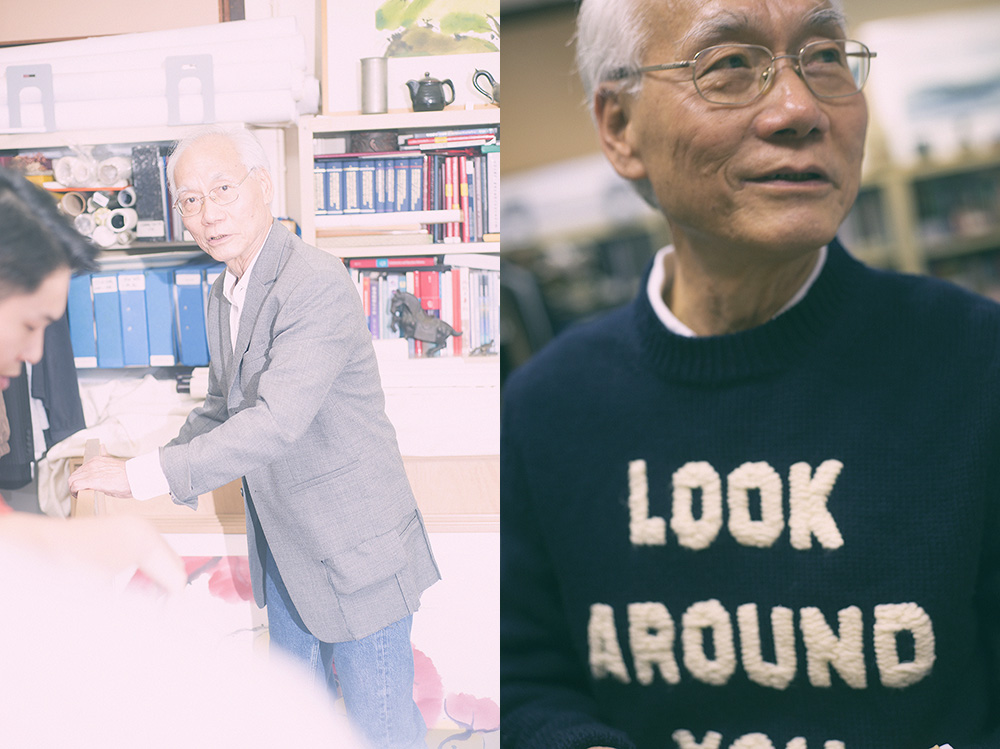
Left/左 : Professor Cheng Yin Cheong blazer by COS, jeans and sneakers by Sandro Homme, white shirt his own. 鄭教授穿上COS 西裝,自已的白恤衫。// Right/右 : He wears sweater by Sandro Homme, white shirt his own. 衛衣和牛仔褲 Sandro Homme,自已的白恤衫。
SP : 「我不認為科學的追求能直接關係到人民的爭鬥,因此我開始對藝術有興趣」這個說法吸引了我的眼睛,你還有這個想法嗎?
鄭燕祥 : 這是很久以前在大學時的感受了。我想現在還有沒有這個想法已經不太重要了。但我確信我很幸運能在當時決定了追求物理以外的藝術。過去40年的藝術之旅改變了我的生活。
SP : 你在2000年才開始展出作品,這是真的嗎?你在70年代就已經開始編畫了,這背後有什麼原因嗎?
鄭燕祥 : 沒錯,確實是2000年。其實1985年我在港中文大學教育學院舉辦過一個小型個人展覽。但作品正式展覽卻始於2000年初,當時得到了多個文化藝術組織的支持。主要是兩個原因,首先,之前也提及過即使舉辦幾天的個人展覽也太貴了 。作為一名普通教師,如果沒有畫廊或贊助商的大力支持,幾乎不可能舉辦任何展覽。其次從80年代中期到90年代,我一直致力於我的學術工作和教育研究。期間我幾乎停止了所有藝術創作,所有的精力、創造力和想像力都在國際學術工作的前線。
SP : 你向我們提及過你正應用一些新技術在你的繪畫技巧上,你能分享多點你在做的這件事嗎?
鄭燕祥 : 正如我所提及過的,水彩畫是一種奇妙的表達方式,但它也有很多局限性。例如很難去創造一個大規模的水彩畫,測試不同顏色變化的視覺效果,同時管理水彩乾燥的時間。大約在2000年,我發現水彩畫可以結合電子處理,增強在創作中的可能性和範圍,並在水彩畫世界中創造一個新的視野。這技術也使我能夠突破傳統水彩技術的局限,改變調色、亮度和外觀,從而創造出全新的視覺氛圍和效果,也同時傳達出藝術家個人風格和所想表達的強烈人文意識。
我將這個創造性的繪畫方法叫做「幹坤挪移」。字面意思是宇宙變換,這個方法突出了陰和陽的相對本質,強和弱、黑和白、高和矮,這一切都可以互換挪移和操縱,以創造全新的視覺氛圍、時空轉移的效果。
過去幾年我也嘗試過用這種方法去體驗香港日與夜的景觀。「幹坤挪移」創造出高對比的視覺效果。作品的效果和轉化也同時表達了我對香港這個港口和城市的情緒。

Artwork : 時空挪移【22】- 錦繡山河【1981/2014】// Space-Time Transforming【22】- Beautiful Country【1981/2014】
如果你喜歡這個訪問可以看看另一個日本藝術家Takeo Hanazawa的訪問:
If you like this article check out our interview with Japanese artist Takeo Hanazawa :
http://blog.spitgan.com/%E8%8A%B1%E6%B3%BD%E6%AD%A6%E5%A4%ABtakeo-hanazawa-funk-phenomenon/
SP : 這個新技術會吸引更多年輕人參與中國水墨畫嗎?你認為他們感興趣的是什麼?
鄭燕祥 : 對的,它可能會吸引到更多年輕人。但我不得不說,新技術只是他們嘗試藝術作品的新工具或新機會。這不能代替他們在藝術創作中的想像和靈感,特別是中國水墨畫。但我確信通過「幹坤挪移」這技術可以提升年輕人的創造力和想像力。
SP : 你在90年代在繪畫上有一段空窗期。然而今日都還有繼續,你認為你真的可以停下來嗎?
鄭燕祥 : 剛才提及過90年代的一段時間我完全致力於教育研究學術工作中。在此期間,我沒有創作任何實質性的藝術品。這在我的藝術生活中確實是一個很大的中斷。幸運的是,我在70、80年代一些最好的藝術作品得到了很好的保護和保存。這些畫作代表了我對藝術生活的深刻又精細的積累,所有畫作都是一種非常熱烈的呼喚,讓我盡可能地繼續我的藝術之旅。
SP : 甚麼是藝術?
鄭燕祥 : 對於不同的人或藝術家來說,藝術的意義可能完全不同。公開討論甚麼是藝術可能會引起很大爭議。就個人而言,藝術就是一方面在外探索我們周圍的世界、另一方面內部探索我們自己的世界,在創作作品之前,兩者之間存在互動過程。
從我畫集「若意挪移」中以下摘錄可能會給出一些見解:
「我創故我在」對我而言,藝術創造是生命的延伸,永遠散發著光和熱。
…我常問我自已我能轉化充滿節奏的生命力和抽象藝術,到具有代表性的繪畫中嗎? 可以將具象藝術精神提升到一個新的水平,成為抽象繪畫的元素嗎?這些與我的內心世界和我對藝術的看法有何關係?這些問題沒有明顯的答案。
在70年代,我開始從描繪自然現象和在城市觀察中尋找更深層次的意義。我試圖去理解繪畫背後的潛在意義和他們的精神、節奏。我希望畫作將以「若意」為指導,在改變其節奏的同時改變外觀和精神。在這過程中,我努力實現新的藝術野心。

Left/左 : Professor Cheng Yin Cheong blazer by COS, white shirt his own. 鄭教授穿上COS 西裝,自已的白恤衫。// Right/右 : He wears sweater and jeans by Sandro Homme, white shirt his own. 衛衣和牛仔褲 Sandro Homme,自已的白恤衫。
SP : 你覺得香港有很好的藝術教育體制嗎?
鄭燕祥 : 我未有對這個問題做過任何研究,可能沒有太多有用的意見和建議。從其他數據中,我們可以看到許多學生的正規課程和考試負擔過重,他們可能沒有太多時間學習和練習藝術。 藝術教育和藝術活動的作用在學校中經常被忽視。
由於香港是一個非常活躍和開放的國際城市,我認為學校教育的藝術發展和創意建設應該有很多好的機會和國際資源。如何為香港教育制度中的藝術教育建立必要的基礎設施和政策,對決策者和有關人士而言是一個很重要的議題。
SP : 現代藝術似乎充滿了故事,有著非常強烈的概念但未必是美麗的。在概念和美之間,那個較為重要?
鄭燕祥 : 這是個有趣的問題。眾所周知,現代藝術在很大程度上拓寬了藝術的意義和範圍。也在某種程度上,藝術的意義已經無限擴展到幾乎包括所有東西事情。藝術是否應該在概念上呈現而不再是傳統上被欣賞,這可能成為了一種哲學論證。如果是這樣,很多人對藝術的意義和目的感到困惑,並在藝術創作中失去方向也就不足為奇了。對他們來說,藝術中對美的追求可能會逐漸消失。
就個人而言,我更喜歡在我的繪畫中同時具有概念和美感。如果我們只有“美”而沒有任何新的觀點或概念,我不認為這種美在人文主義中將具有持久的價值。但如果我們只強調“概念”而沒有任何美的元素,那麼我們就很難理解為什麼它仍能是一門藝術。
看看另一條香港音樂人恭碩良的訪問:
Check out our interview with Hong Kong musician Jun Kung here :
http://blog.spitgan.com/jun-kung-hong-kong-recording-artist/

Artwork : 天地挪移【8】- 山氣【2001/2016】 // World Transforming【8】- Mountain Sporot 【2001/2016】
SP : 在我們聯絡你時,你似乎很驚訝,為什麼?
鄭燕祥 : 在我而言,我不屬於你們的世界,時尚界。雖然我理解時裝設計從現代藝術和設計中獲益很多,但我的藝術作品可能仍然偏離您的行業。特別是…我的一些藝術作品已經是40年前了。因此,我很想知道你們為什麼想跟我訪談。也許你已經想過了時尚藝術和我的藝術之間的界限,因此就讓我們聊聊吧。
SP : 我們應該如何去理解/欣賞中國水墨畫? 或者你的作品?
鄭燕祥 : 中國的水墨畫有很多不同。對於不同的人來說,他們喜歡的中國水墨畫的風格和視覺效果可能會有所不同。你喜歡什麼的中國水墨畫可能是開始理解和欣賞之前的問題。
在我看來,水彩畫和中國水墨畫之間應該沒有太大區別,它們都只是一種工具。關鍵是我們如何能夠恰當地利用它們來表達我們所想追求的東西,並以自己的風格進行繪畫。
當然,我歡迎有興趣的人將我的作品作為一個開始。
SP : 藝術家在香港面臨的獨特挑戰是什麼?
鄭燕祥 : 在過去的40年裡,我認識了很多香港藝術家。他們中的大多數都是業餘藝術家,努力在他們的職業生涯和藝術興趣之間取得平衡。很少有人可以靠“全職”藝術謀生。
我認為香港藝術家面臨的獨特挑戰包括展覽和推廣藝術作品的成本高昂、缺乏藝術創作的工作空間、也缺乏一大批著名藝術家帶領他們,以及缺乏強大的文化和市場支持藝術活動。
SP : 有些人認為繪畫將消亡,並由攝影取而代之。你覺得這儚概念如何?
鄭燕祥 : 繪畫和攝影是兩種不同的東西,代表不同類型的藝術活動。很難進行任何比較。在商業世界中,配備高科技相機的攝影似乎是一種比繪畫更有力和更有效的謀生和建立聲譽的方式。越來越多的人喜歡攝影而不是繪畫,這並不奇怪。但在自由藝術想像和情感表達方面,我相信繪畫仍然比攝影更好。
SP : 我們怎樣才能重新燃起對中國水墨畫的興趣以免它消失?又或者這是一個自然的過程?
鄭燕祥 : 正如我早前講過,中國水墨畫/水彩畫與新技術的融合可以擺脫傳統的局限,增強創作可能性的範圍,在傳統世界中發現新的視野。我相信這種創造性的方法「幹坤挪移」有助於重新燃起他人對中國水墨畫的興趣。
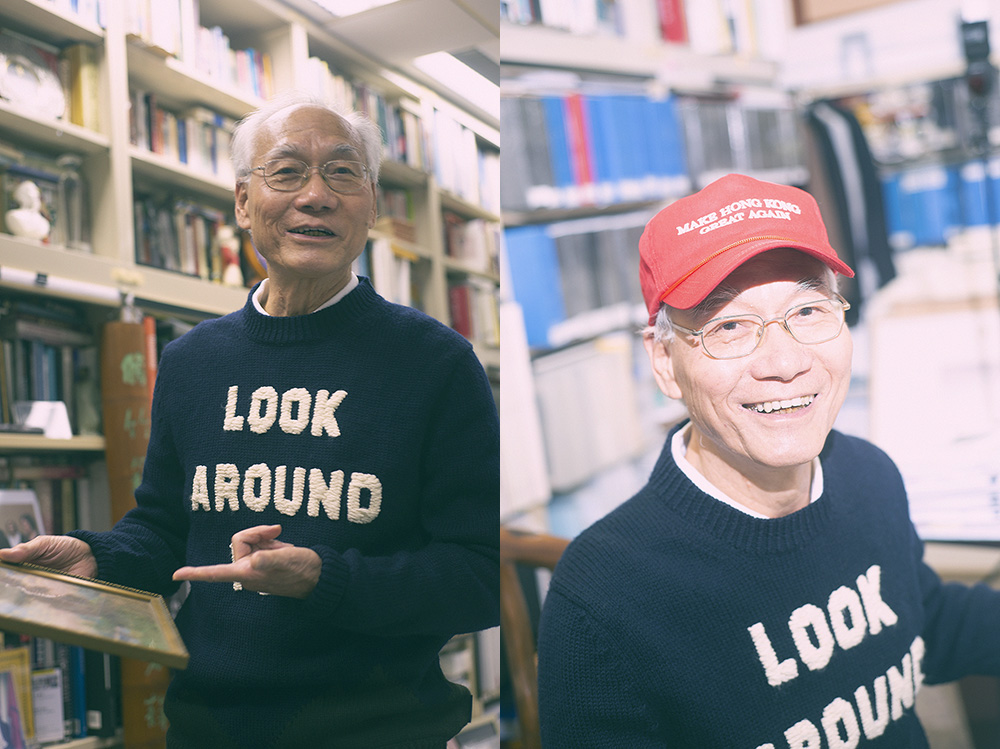
Left/左 : Professor Cheng Yin Cheong sweater by Sandro Homme, white shirt his own. 衛衣和牛仔褲 Sandro Homme,自已的白恤衫。// Right/右 : He wears hat by STR3AK Clothing, sweater by Sandro Homme, white shirt his own. 帽STR3AK,衛衣和牛仔褲 Sandro Homme,自已的白恤衫。
SP : 你現在的作品,做能為我們描述這個時期嗎?
鄭燕祥 : 最近出版了我的新藝術畫集「若意挪移:鄭燕祥創作畫集」,在過去40年,我對我的藝術世界有了更全面的了解,並創出「幹坤挪移」這個新的應用方法。目前,我正在進一步嘗試將「幹坤挪移」應用到我的不同類型的藝術作品中,以測試我在用於視覺藝術創作中的「相對論」。希望這個理論可以幫助藝術愛好者或藝術家欣賞藝術創作背後的意義和動力,並發現他們自己表達自己世界的方式。
我現在正在尋找一位商業贊助商,他可以通過這種方法在香港製作和展出大型藝術品來支持這項實驗。 讓我們來想像一下香港人如何回應這項藝術倡議。
你有興趣成為贊助商嗎?
SP : 請與我們分享一些你欣賞或啟發你的香港藝術家。
鄭燕祥 : 我很喜歡陳餘生先生、韓志勳先生和夏碧泉先生的藝術作品。在香港藝術館準備三場公開講座時,我對他們的藝術作品進行了很全面的研究。他們獨特的創造力和終身藝術成就給我留下了深刻的印象,並深受啟發。作為香港人,我們為他們感到自豪。

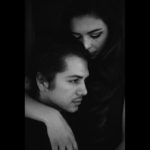
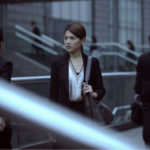
Speak Your Mind